Well hello there! Koby from the AQ Ambassador team here and today I’m going to help you pick your first whitewater kayak. While this may be a daunting task with all the options out there these days, it’s also one of the most exciting parts of learning to paddle!
To make sure your first whitewater kayak is a good one, I’ve gone ahead and broken the entire process down into three simple steps, with a few key considerations along the way to guide your decision.
But before we embark on this journey, you’re going to need a little background on the sport of whitewater kayaking, especially the difference between playboating, river-running and creeking. If you’re still a little shaky on that stuff it’s a good idea to start with this Intro to Whitewater Kayaking, otherwise read on.
AQ Outdoors Whitewater Kayak Collection
How to Choose a Whitewater Kayak
Step 1. Pick the type of kayak (creek boat, playboat, or river-runner) you want to start with
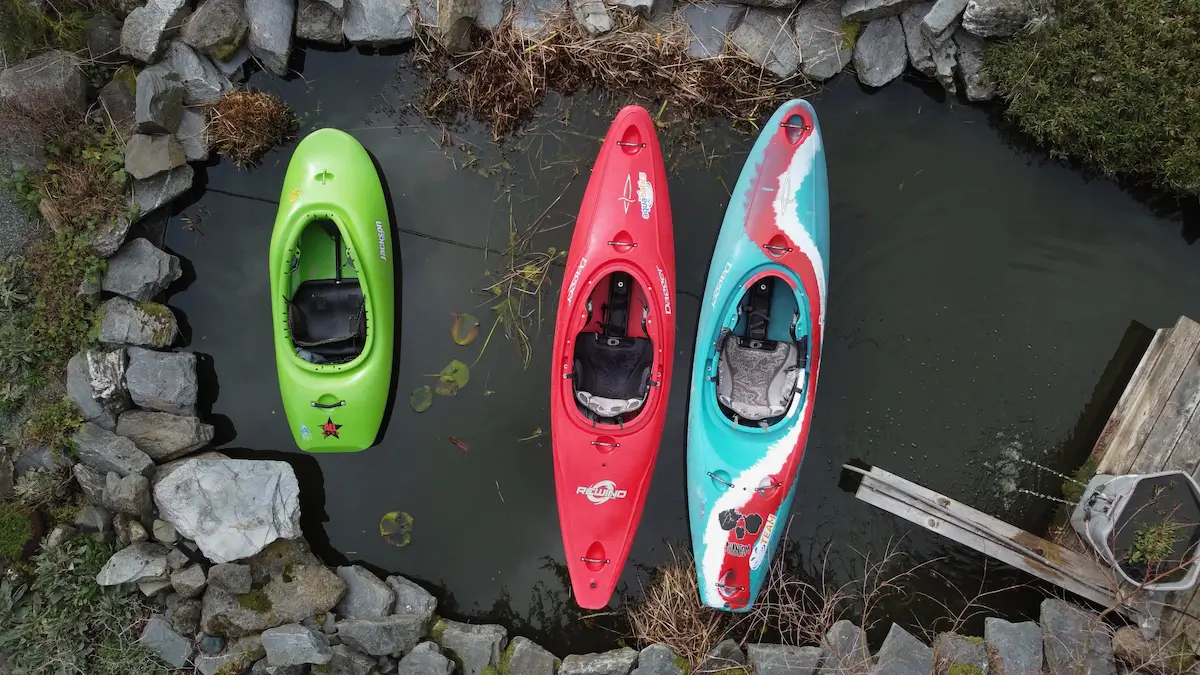
From Left to Right: Playboat, River-Runner, Creekboat
The very first step in choosing a whitewater kayak is considering what type of whitewater kayak you actually want. This is the most important step because whichever type of kayak you choose will greatly influence your experience of learning how to paddle.
The most important considerations when making this decision are:
- Where your live and which river(s) you will be paddling most often (If you don’t know then it’s a good idea to look to your community to see what type of kayak everyone else is using, or even better ask for local advice!) It’s best to buy a whitewater kayak that maximizes your enjoyment of the rivers you paddle most often ☺
- What type of kayaking interests you the most
- Your learning style
- Your comfort levels on the river and upside down in a kayak
For this to be more best understood, let’s explore how the three main types of whitewater kayaks relate to these four key considerations.
Creekboats
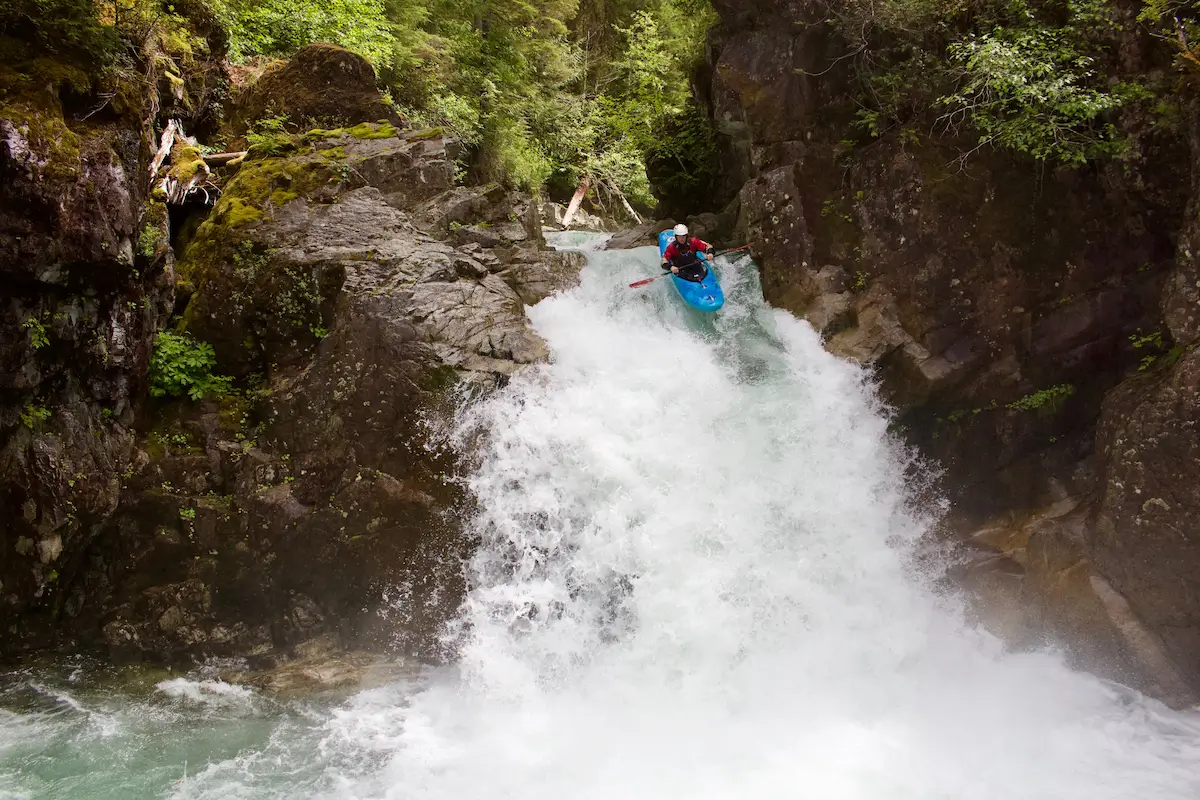
Waterfalls aren’t by means a mandatory part of whitewater kayaking, but they can be magical.
Creekboats are the largest type of kayak on this list. Their size assists the paddler in staying on top of river features such as waves and holes, which provides control and predictability in the gnarliest of rapids.
The trade-off is that they are intentionally boring, meaning they are designed to give paddlers the best chance of making it from the top to the bottom of a rapid while remaining in control and upright as opposed to playing on the river doing things like surfing waves.
While suitable for class I-V whitewater, creekboats are best for paddlers looking to paddle rivers near the top of their skillset, whether that is class III or class V.
Some reasons you might choose a creekboat
- Best if you will be paddling mostly on shallow, cold and/or fast rivers where going upside down is best avoided
- You’re most interested in just paddling down the river, and the rapids and places you get to explore provide the excitement you seek
- You prefer the easiest learning option, and don’t mind a kayak that lets you get away with mistakes
- You’re not naturally super comfortable on the river nor going upside down, and thus will benefit from a kayak that eases you into the sport*
(*note that going upside down is inevitable in whitewater kayaking however, and flipping often while learning can help improve both your river comfort and your combat roll)
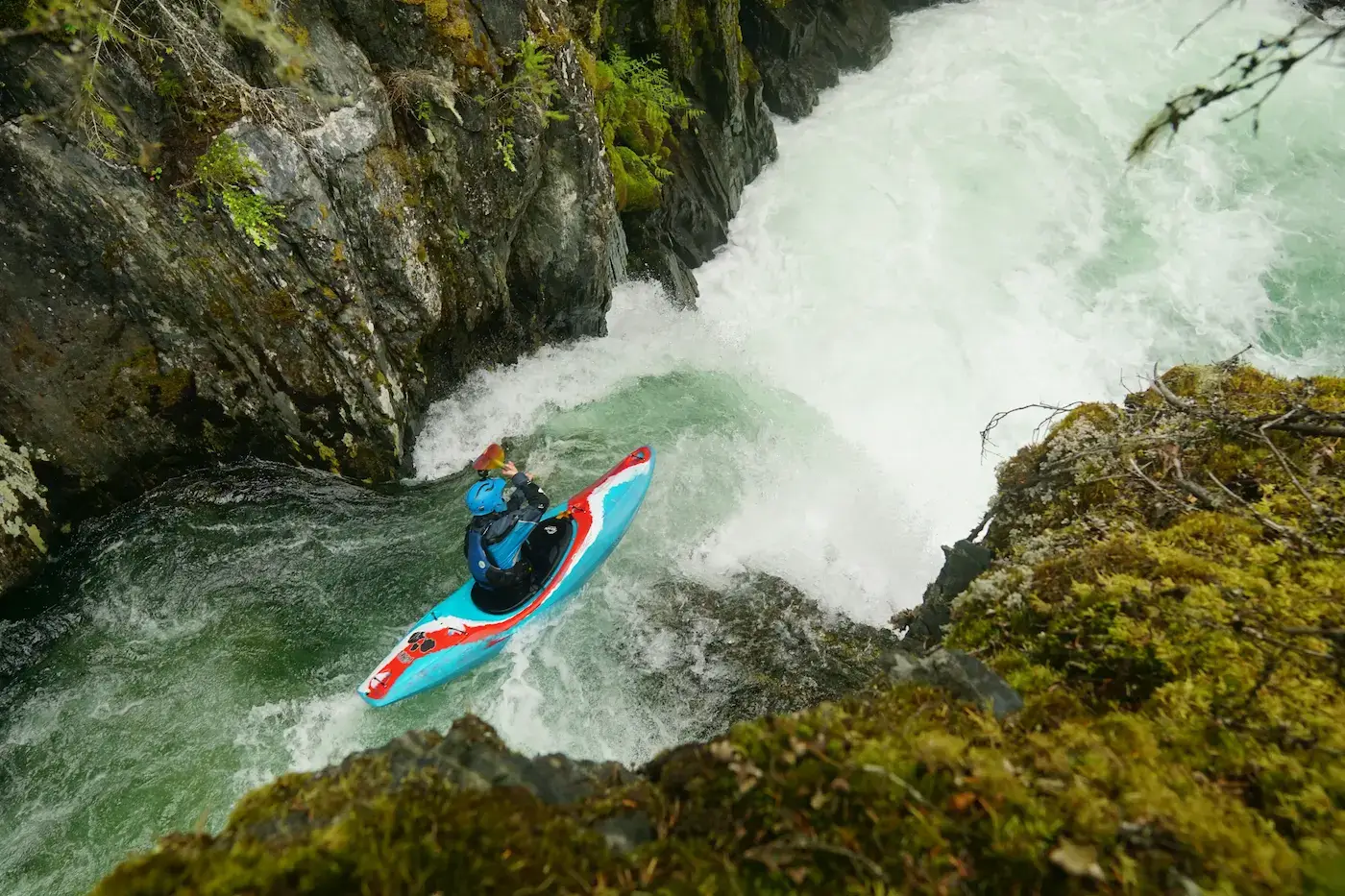
Creekboats are designed for big rapids and waterfalls, but they also provide a stable platform for beginners.
Koby's Creekboat Pick
One of the best creekboats for beginners on the market right now is the Dagger Code. It has a nice balance of speed, maneuverability and stability, is extremely comfortable and will not become obsolete due to your paddling progression, as it is suitable for experts as much as beginners.
Dagger Code Medium Kayak

$2,149.00
The Dagger Code Medium is a fresh take on the iconic Mamba series of creek/river-running kayaks. Featuring a planning hull, wide stern profile for enhanced stability, and high-rise bow rocker, the Code provides excellent performance. Paired with the Contour Ergo… Read More
Playboats
Playboats are designed for surfing waves like this one, Pink Mountain Wave on the Clearwater River in BC. *Video has no audio.
The smallest style of whitewater kayak on this list, playboats are designed for surfing waves and playing in river features such as holes. If the river you're intending to paddle has these features, a playboat will help you capitalize on them to the fullest.
A few rivers in Western Canada that are awesome to playboat are the Kananaskis, Harvie’s Passage, Clearwater, and the Slocan/Kootenay/Columbia near Nelson.
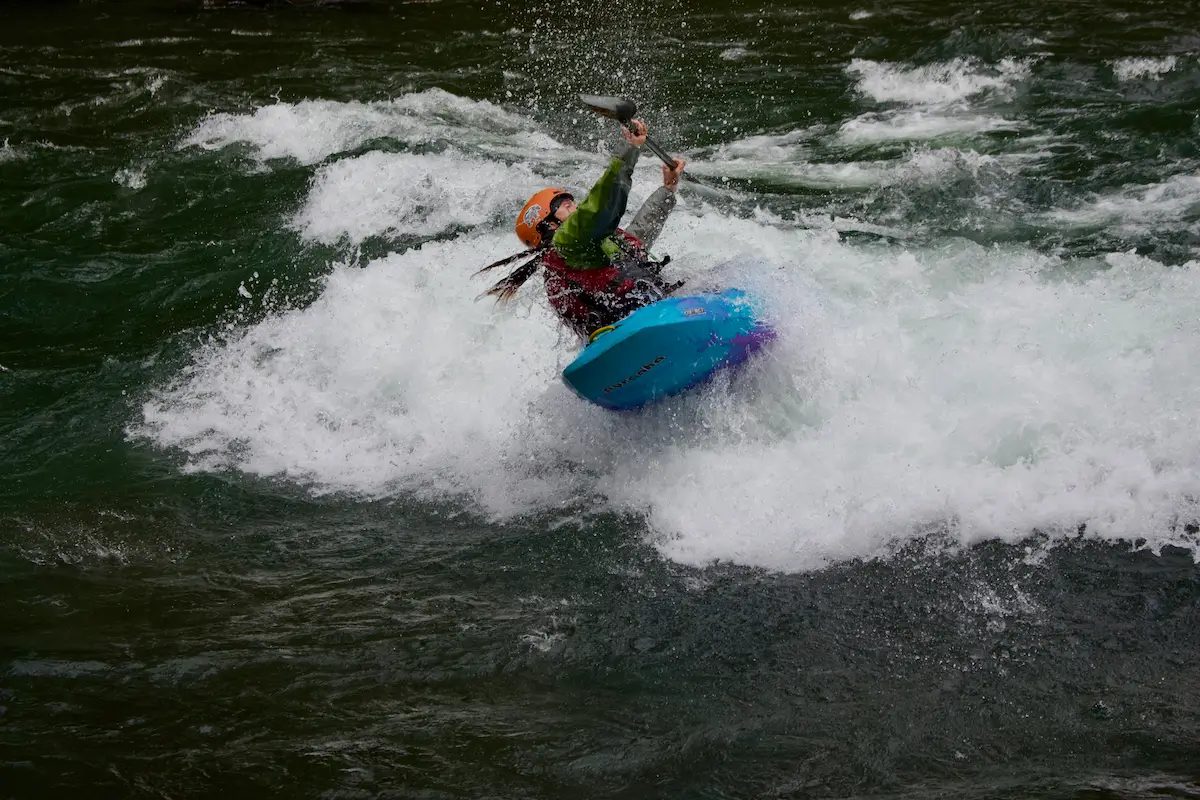
Throwing down on standing river waves is the name of the playboating game.
The con of playboats is that due to their small size, they are inherently tippier than other kayaks, and don’t excel on smaller creeks or more challenging whitewater. Because of this, the majority of playboat use is on Class I-III whitewater.
Some reasons to pick a playboat
- Best if you will be paddling mostly on rivers that have many surf waves and other “play features”
- You’re most interested in playing around, and surfing waves and learning to do tricks on the river. Waterfalls/drops and other more extreme aspects of the sport may be less interesting to you right now
- You are a somewhat patient learner who is willing to repeatedly try things again in the process of learning
- You may or may not be inherently comfortable with big rapids and fast rivers, but you aren’t terrified of being upside down. Can be also be a great option for building comfort with being upside down
Koby's Playboat Pick
Jackson Kayaks has been the leader in playboat design for the 11 years I’ve been kayaking. Whilst I still paddle a Jackson Playboat from 2010, the Rockstar V is the best of the best for playboats currently on the market.
Jackson Rockstar V Medium

$2,099.00
$2,322.00
The all new Large Jackson Rockstar V (5) takes 20 years, and 8 generations of playboat building knowledge, experience, and lessons learned along the way to create the best playboat Jackson kayak has ever made. Jackson Kayak's legacy starts with… Read More
River-Runners
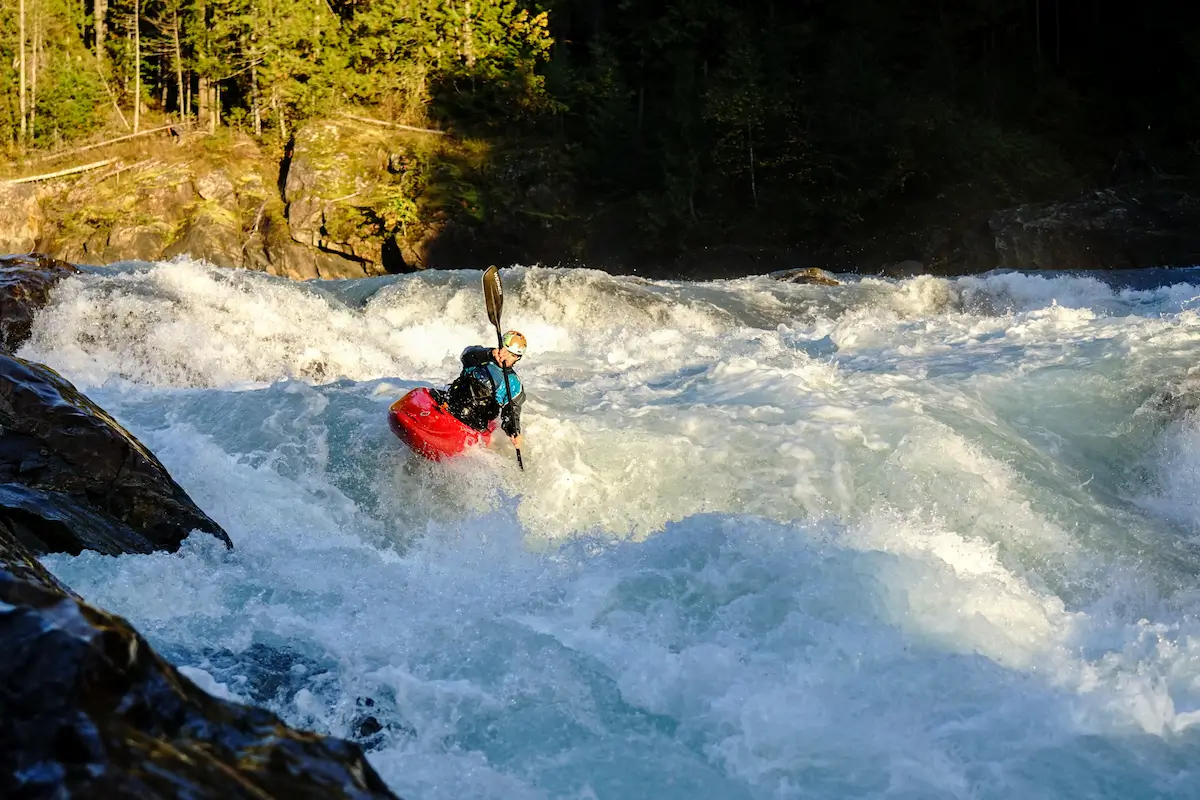
Half-slice boat in traditional creekboat territory.
Over the past few decades, ‘river-runners’ have been redesigned many times as different trends come and go. However, the philosophy of river runners has always been the same, make a kayak capable of running class V that is also fun to paddle on class II.
River runners can still be playful
Today river-runners fall into two main categories, full-slice and half-slice. Don’t let the jargon intimidate you, slice just refers to if the bow (front of a kayak) or stern (back of a kayak) is low volume (thin).
Full slices are kayaks that are thin both in the bow and stern, whereas half-slices are only thin in the stern and thus are essentially a blend between creek-boats and a full-slice boat.
Full-slices are more akin to playboats, and less geared towards running hard whitewater, whereas half slices-retain the class V capability of a creekboat while still being able to take advantage of a river's play features.

Full-Slice Kayak; Note the thin nose and tail

Half-Slice Kayak: Note the thin tail while the bow is fat and rockered
The pros and cons of a river-runner is that it is a jack of all trades, and the master of none, but they are without question the most fun type of kayak on the largest variety of rivers, and for that reason I personally spend about 75% of my time paddling in a half-slice.
Some reasons you might pick a river-runner
- Best if you live near a variety of different style rivers, and/or the rivers you will be paddling most are a mix of surf waves and challenging rapids
- You’re not completely sure what type of whitewater kayaking interests you the most, but you want to surf and play as well as step up to challenging rapids
- You’re willing to learn in a kayak that may be more challenging at first but will help you develop better technique for the rest of your paddling career
- You are comfortable enough with the river (or determined enough to get over your fear) being upside down more often when learning will not deter you from pursuing the sport
Koby's River Runner Pick
I’m a huge fan of half-slices and the Dagger Rewind is my #1, however I also have much love for the Pyranha Rippers and Jackson Antix 2.0, any of which would be a great boat to start a paddling career in.
Dagger Rewind Medium Kayak

$2,149.00
Dagger has a reputation of creating boats that not only define an era but stand the test of time; the all-new Dagger Rewind Medium Kayak is an instant classic and an award-winner. An ultimate downriver play boat for paddlers of… Read More
Step 2: Consider your budget…
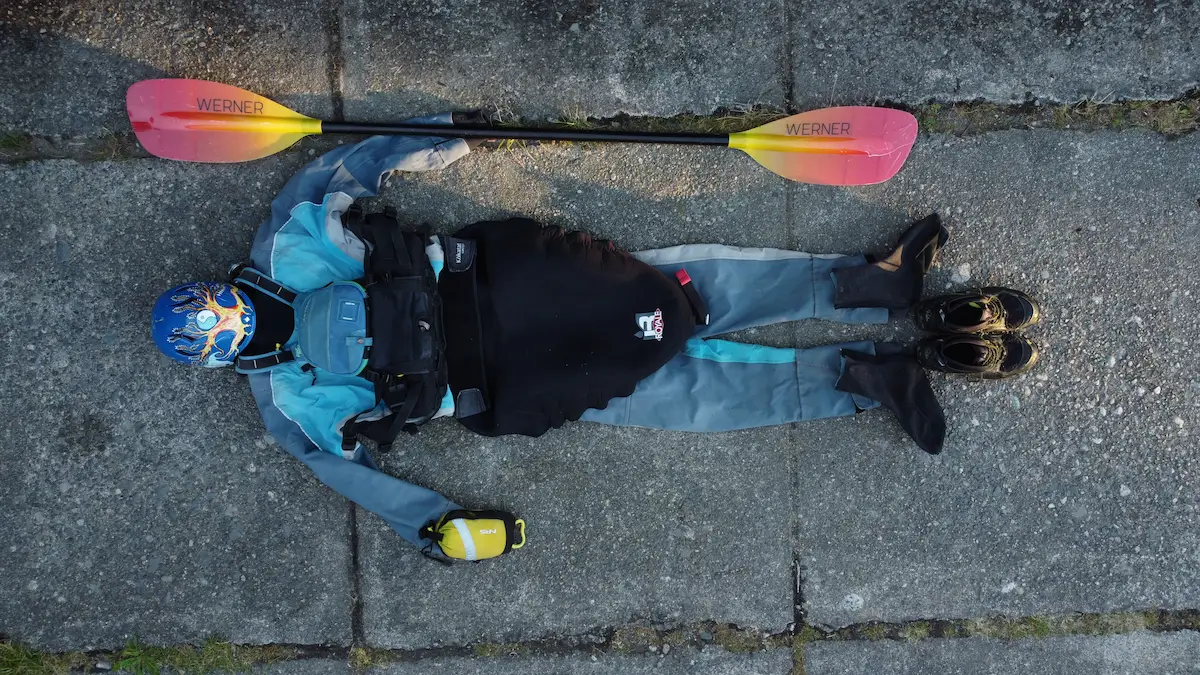
Don’t forget to save some money for the rest of your kit…
The second consideration you must make is how much money you are willing to spend when choosing a whitewater kayak. Keep in mind a kayak is only one piece of your kit, other whitewater essentials like a drysuit or drytop, paddle, lifejacket, spraydeck and helmet should also be included in your budget.
Whitewater kayaks can be found at a huge range of prices, usually starting around a few hundred dollars, and going all the way up to the two-thousand-dollar mark for something brand new.
The price of a kayak is most often a reflection of its age, condition, and the popularity of the design. Therefore, one of your biggest decisions will be new, or used.
Keep in mind that kayaks are not like mountain bikes, very little has changed regarding their components and construction over the past twenty-five years. For that reason, many old kayak designs are still wildly popular, and a used kayak is often a great way to get into the sport at a much, much lower price point.
Pros and Cons of NEW Kayaks
Pros
- Shiny…. ☺
- Comfortable (good outfitting)
- Most modern designs really do make kayaking easier
- Not limited to availability of designs on used market
- Warranty (against manufacturer defects only though, not if you break it)
- Lifespan (plastic wears out and cracks over time, new boats are at the start of their life)
Cons
- Price (can be significantly more expensive than a used kayak)… ☹
- Risk of loss/breaking*
*When you start kayaking it is likely your kayak will go on many self-piloted adventures down the river. Every time this happens there is a risk the kayak could get lost or broken, and the manufacturer’s warranty does not cover it if it does).
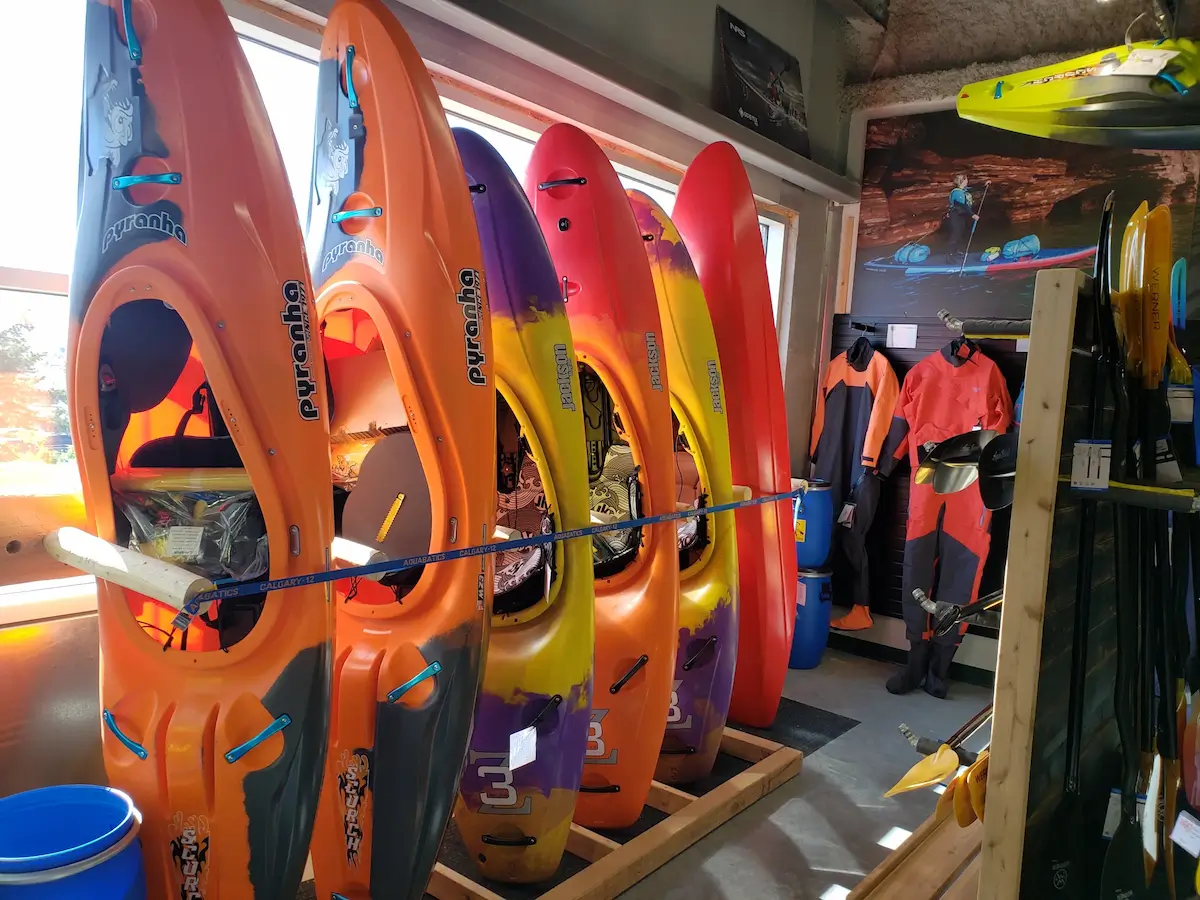
Some shiny plastic on the rack at AQ Outdoors Calgary
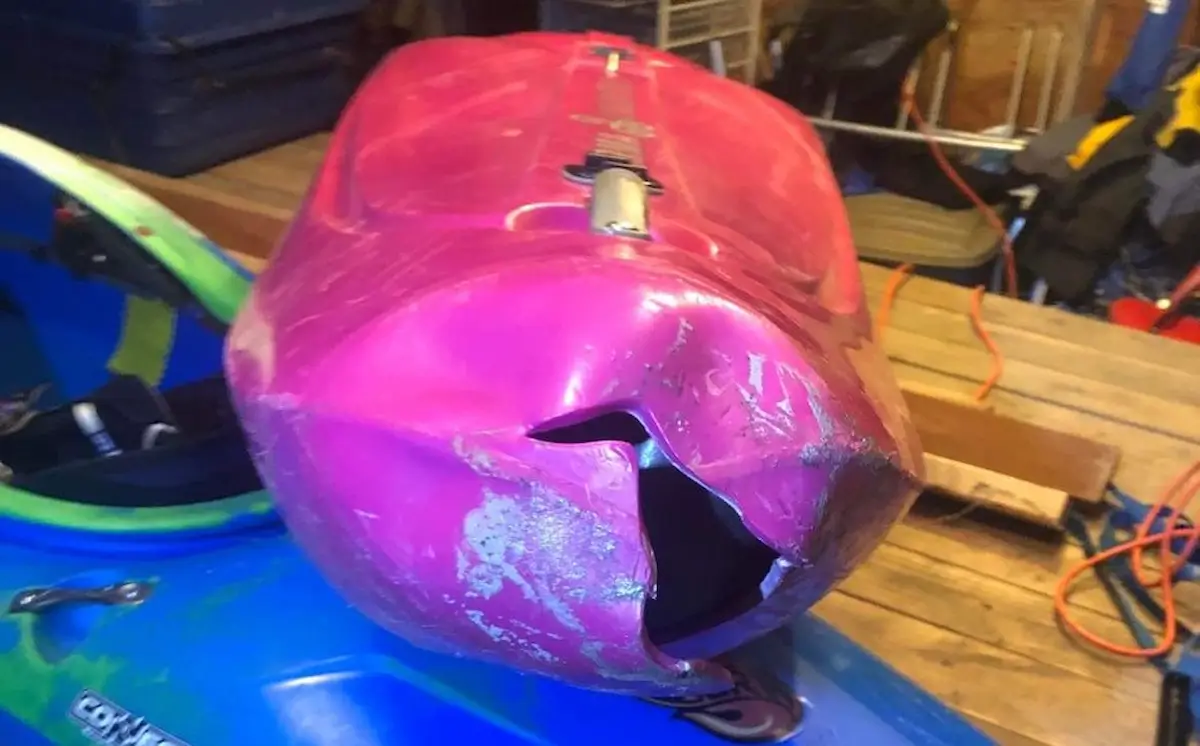
Even fresh plastic is sometimes put through something it can’t survive…
Pros and Cons of USED Kayaks
Pros
- Affordability
- Many older kayak models are still excellent designs, especially for learning
- Less money spent means less lost if the kayak is lost or broken
- Less money spent on one kayak might mean you have enough for two different types of kayaks (e.g., a playboat and a creekboat)
Cons
- No warranty
- Selection limited to what’s available on a competitive market
- Some knowledge required to the assess the condition of a used kayak
- May have less longevity than a new kayak because of previous wear
- Some old kayak designs are truly awful
- Older kayaks are often less comfortable (poor outfitting)
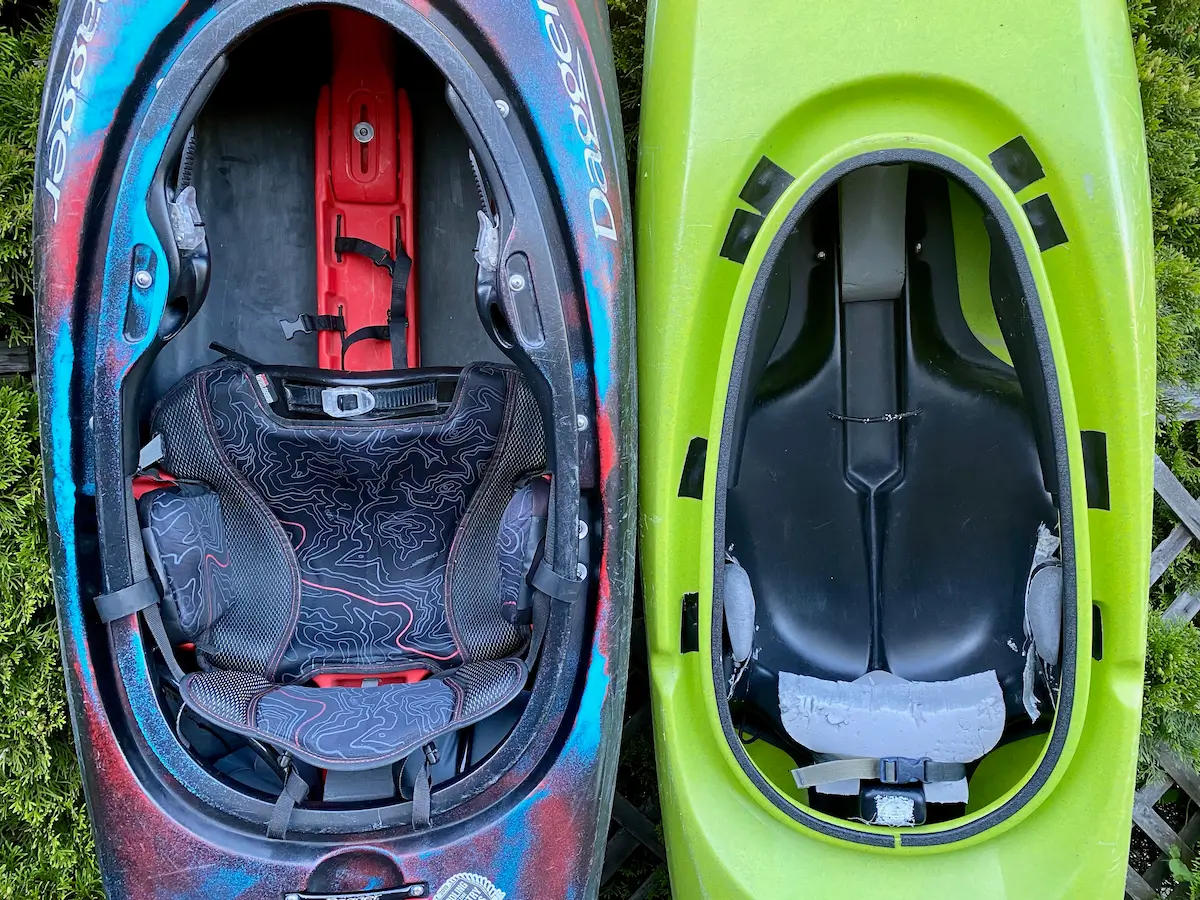
The outfitting of new kayaks (left) is comfortable and supportive, whereas older kayaks (right) are typically limited to hard plastic and the foam that you tape/glue in.
Another option if you’re set on getting a new boat but can’t lay down the cash all at once is AQ’s financing program which can help you get kitted out with a brand-new boat immediately while simultaneously motivating you to keep your job.
Step 3: Pick and brand, model, (demo) and purchase! (or maybe wait a little bit…)
By now you should know the type of whitewater kayak you are looking for and if you’re looking for something new or used. The last consideration is specific brand and model of kayak you will purchase.
If you can, demoing the kayak you are interested in or at least sitting in it before buying is best practice. This will let you will know how well the kayak fits you, and maybe if you like how it feels on the water. AQ Outdoors offers 24hr demos at a cost of $25 + GST, which can be credited towards your purchase if you decide to take it home for keeps ☺.
If you are lucky enough to be in the market for a brand-new kayak, keep in mind that today every whitewater kayak brand has some good designs, and the final decision really comes down to personal preference and fit.
That being said, some of the brands you are likely to see in your search are Dagger, Jackson and Pyranha.
Dagger is known for durability and comfortable outfitting; however, they are also known for being heavy which can make trips between the river and your car with the boat on your shoulder less enjoyable.
Jacksons are known for being light, beginner friendly and leaders in playboat design.
Lastly, Pyranha is the company driving design innovation in whitewater kayaks (apart from playboats) for the past decade, however their outfitting is infamous for being trickier to get comfortable.
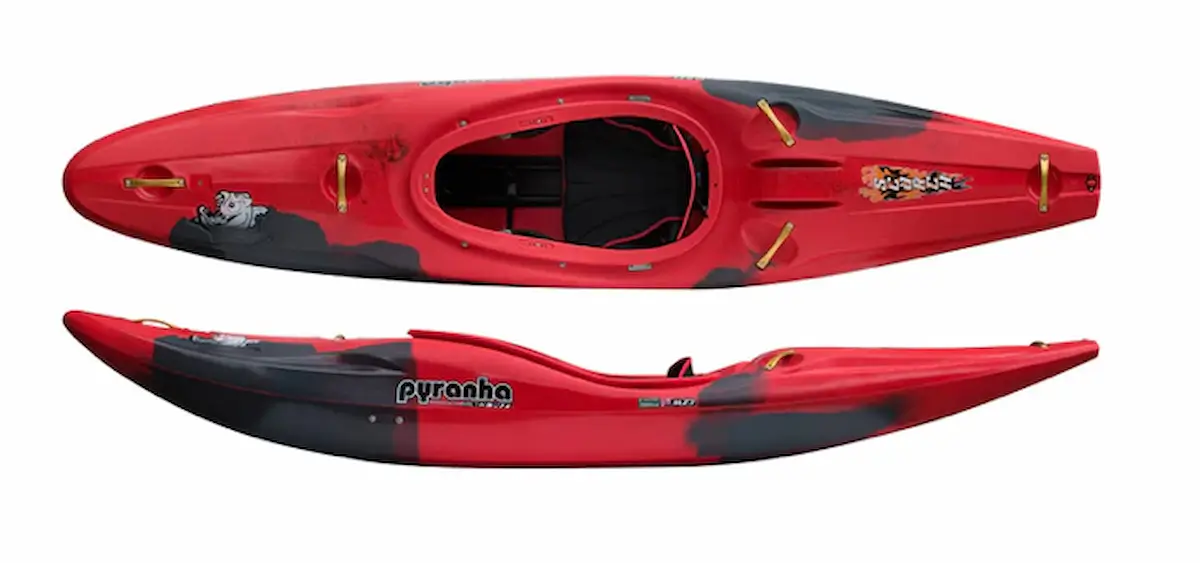
The 10-foot-long Scorch X is the latest example of Pyranha’s willingness to test out radical new design concepts.
How to Choose a Used Whitewater Kayak
If you are limited by your budget to what is available on the used market, I strongly recommend asking the opinion of someone more experienced before purchasing. If you don’t know anyone personally, local whitewater clubs or shops will be more than happy to provide some purchasing advice.
There are literally hundreds of used whitewater kayak models out there, and it can take an experienced eye to look at one and know if it’s any good, and if it’s priced fairly.
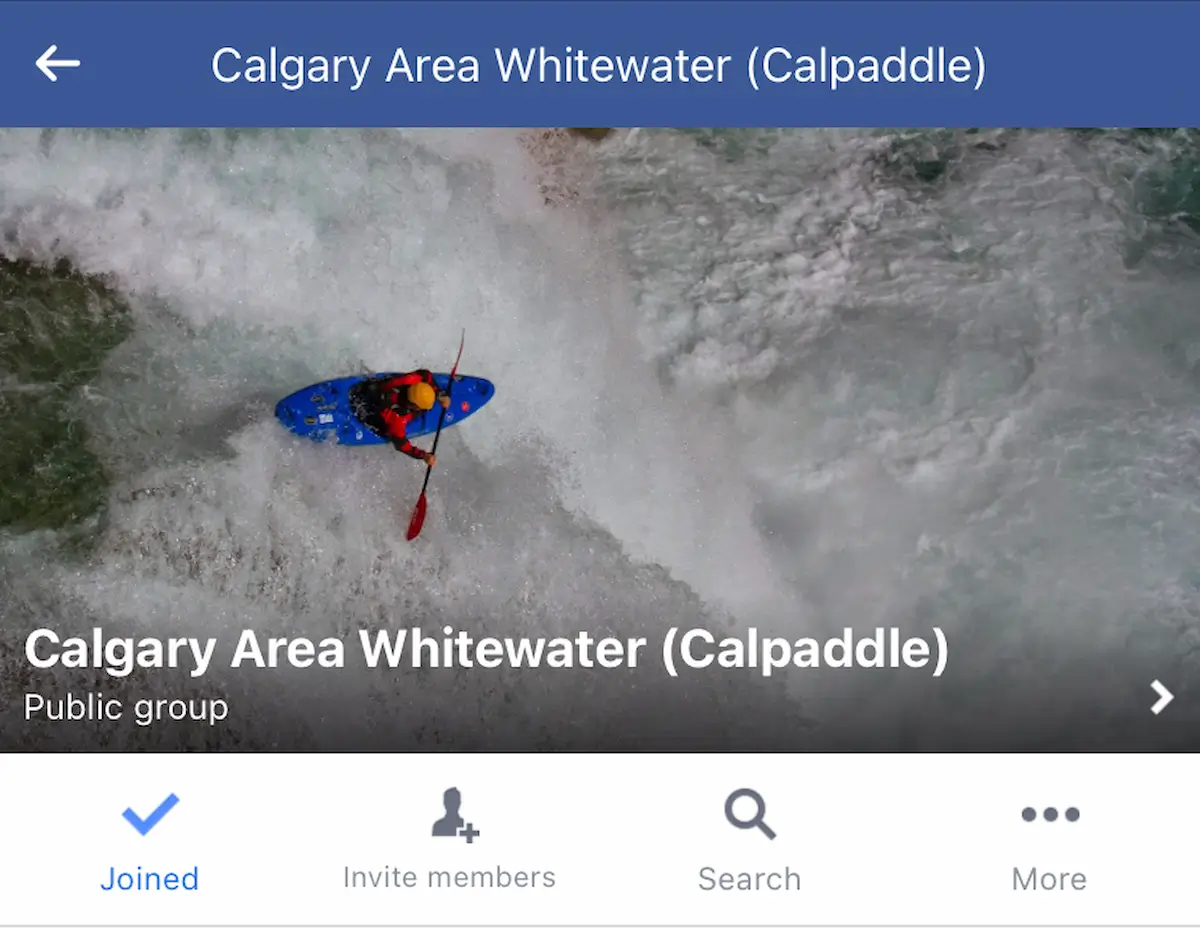
Local whitewater social media groups can be a treasure trove of information and advice.
If you do take on purchase of a used kayak yourself, be sure to do some preliminary internet research regarding how the design is regarded in the community and try and find out how old it is.
Creekboats have improved greatly in the last decade, playboats are typically all pretty good from 2010 forward, and river-runners can be great from the mid 90’s to present but not all models are great.
When looking at the boat itself be sure to check the plastic for deep gouges, dents, deformations, and cracks. Check the outfitting to make sure it is all intact and not too worn or torn and be sure to check that all the screws and bolts are in place with none missing.
Lastly, sunlight destroys kayak plastic and thus kayaks stored indoors or at least out of the sun have a significantly better shelf-life than those stored out in the elements.
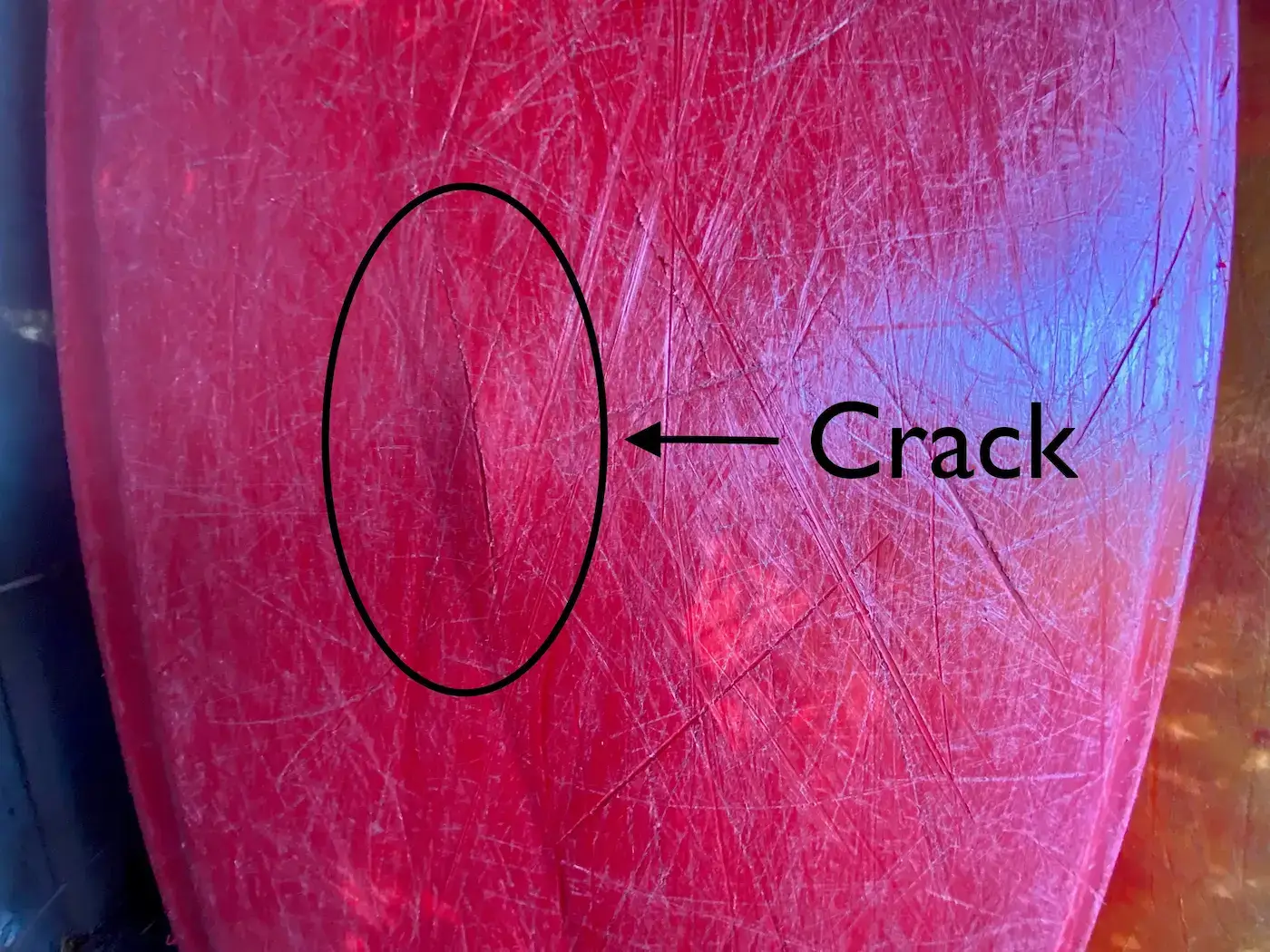
The hull (bottom) of the kayak is among the most important things to check. The kayak pictured is very worn and even cracked, a condition to avoid in most circumstances.
I hope after reading this you are feeling confident in your quest to choose and buy your first whitewater kayak.
Remember that the most important considerations are:
- Where you will be kayaking most often as you learn
- What discipline of whitewater kayaking interests you the most
- How much money you have to spend. And don’t forget that it’s not a forever decision either!
Everyone ends up buying, selling, swapping and switching out kayaks throughout their career, it’s all part of the fun of this wonderful sport that really is just taking plastic tubs down a river ☺.
Happy Paddling,
- Koby
AQ Outdoors Whitewater Kayak Collection
Related Whitewater Kayaking Articles
Beginner's Guide to Whitewater Kayaking
Beginner's Guide to Whitewater Kayaking Gear
AQ Outdoors Contact
Edmonton: (p) 780 463-4892 (e) info@aquabaticsedmonton.com
Calgary: (p) 403 288-9283 (e) info@aqoutdoors.com




















































